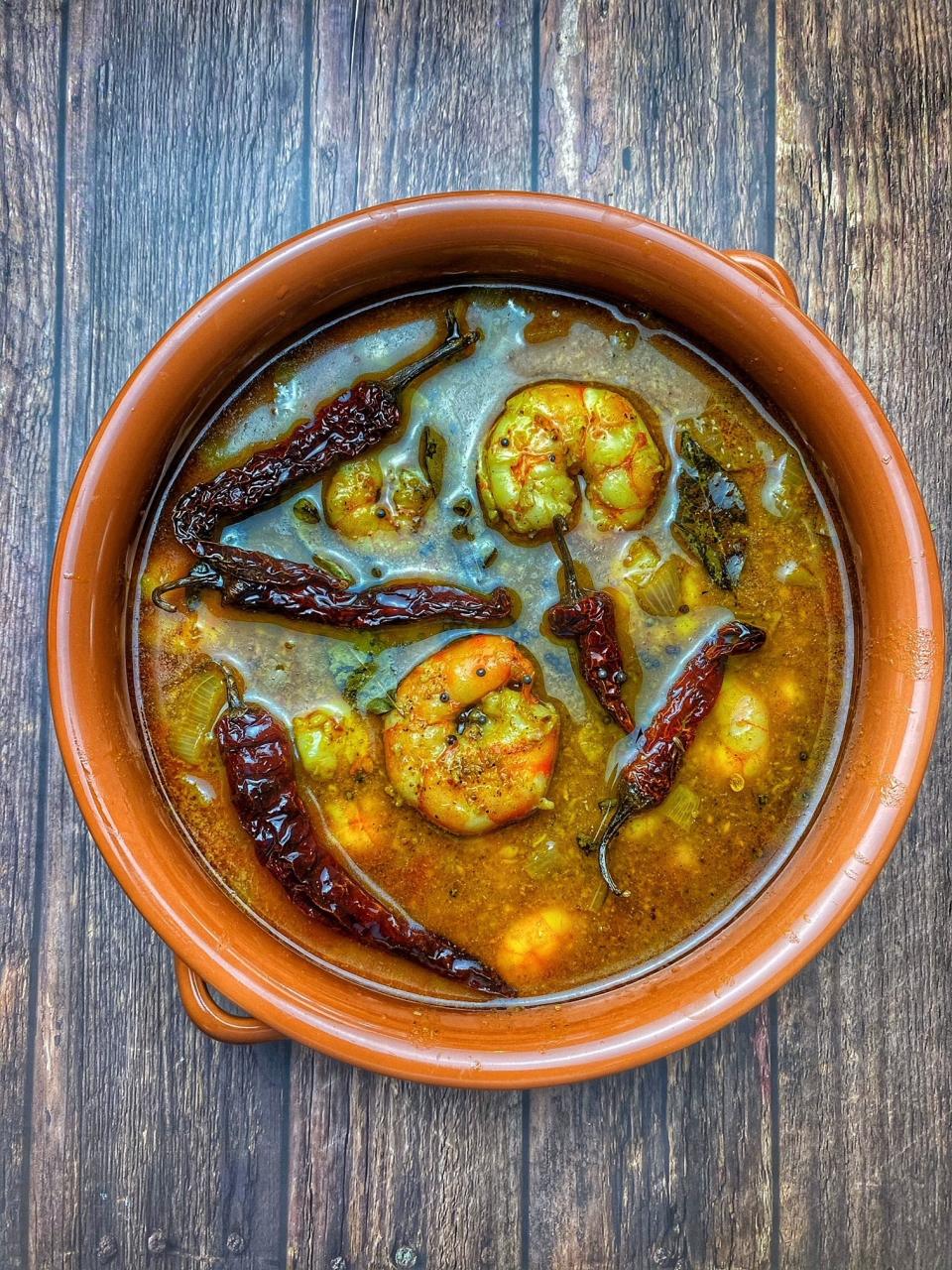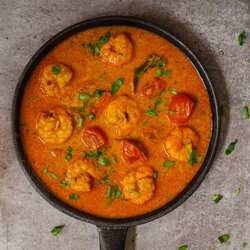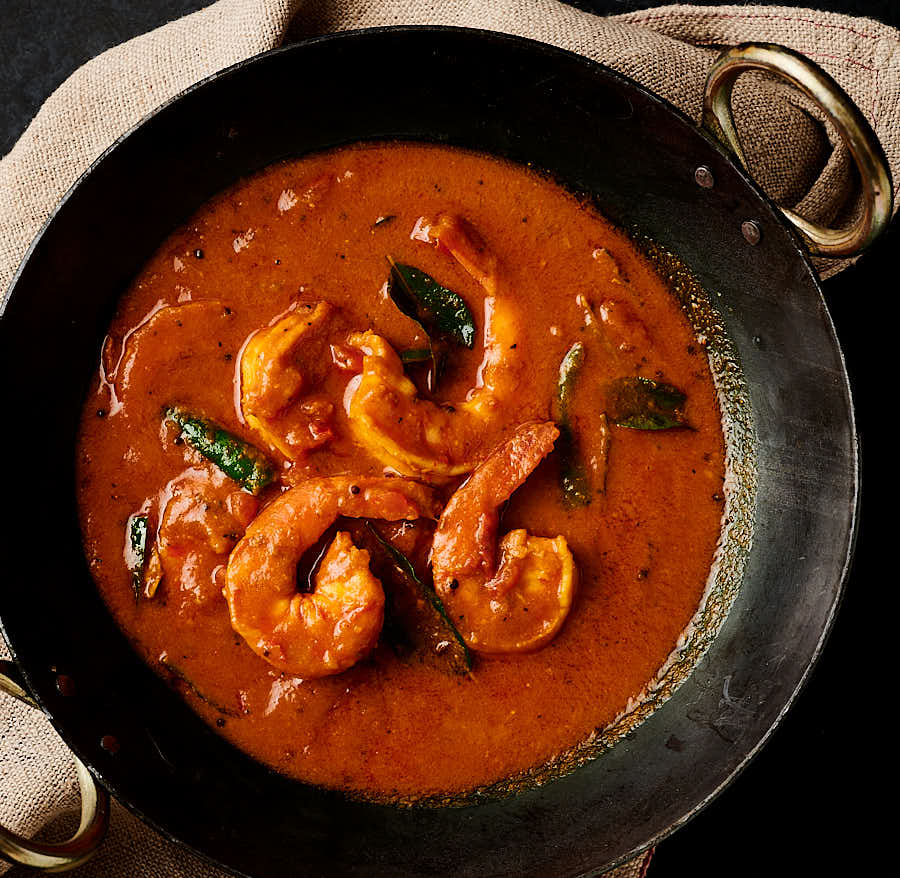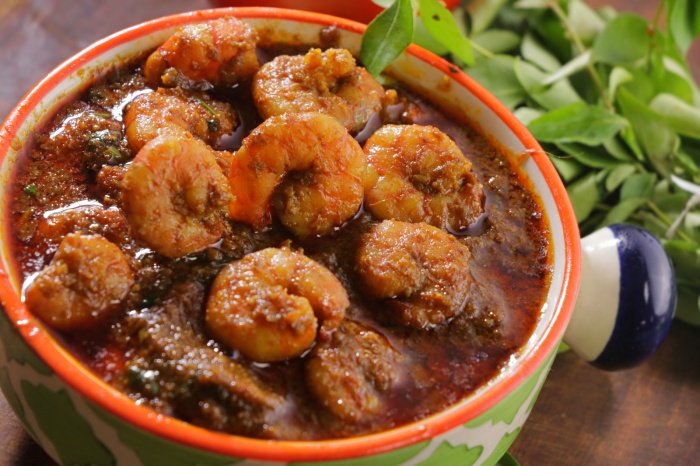Malabar-Style Prawn Soup is a flavorful and aromatic dish hailing from the coastal regions of the Indian subcontinent, particularly within the Malabar coast known for its rich culinary heritage. This cuisine blends the traditional flavors of Kerala with influences from Arabian, Persian, and European traders who frequented the region, creating unique and diverse culinary masterpieces.
The soup is crafted using juicy, tender prawns that serve as the base protein, bringing a subtle sweetness that perfectly complements the spicy and richly seasoned broth. Key ingredients often include coconut milk or coconut cream, giving the soup a creamy texture and a slight sweetness that balances the heat from the green chilies, black pepper, and other local spices such as mustard seeds, curry leaves, and turmeric. The presence of ginger and garlic adds depth and warmth to the dish, enhancing its flavor profile.
Malabar-Style Prawn Soup Recipe


Malabar-Style Prawn Soup
Equipment
- 1 dry skillet
- 1 medium pot
Ingredients
- 2 teaspoons coriander seeds
- 1/2 teaspoon peppercorns
- 1/2 teaspoon mustard seeds
- Pinch fenugreek seeds
- 2 curry leaf sprigs
- 1 large onion sliced
- 2 green chiles stemmed and seeded
- 1 1-inch piece fresh ginger, peeled and sliced
- 2 garlic cloves peeled
- 1 tablespoon coconut oil
- 1/2 teaspoon ground turmeric
- 3 cups fish stock
- 8 ounces shrimp peeled and deveined
- 1 cup full-fat coconut milk shake the can before opening and measuring
- 2 tablespoons freshly squeezed lime juice
- Salt
Instructions
- In a dry skillet over medium heat, combine the coriander seeds, peppercorns, mustard seeds, fenugreek seeds, and curry leaves. Toast until the mustard seeds begin to sputter and the spices are slightly brown, about 1 minute. Remove from the heat and set aside to cool.
- Transfer the cooled spices to a spice grinder or clean coffee grinder and grind into a fine powder. Set aside.
- In a blender or food processor, combine the onion, green chiles, ginger, and garlic. Process until smooth.
- In a medium pot over medium-high heat, heat the coconut oil.
- Add the onion mixture to the skillet and sauté for 2 to 3 minutes, stirring frequently, until it no longer smells raw.
- Add the spice powder to the onion mixture with the turmeric. Cook for 2 minutes, stirring constantly. If needed, add 1 to 2 tablespoons of water to prevent burning.
- Add the fish stock and stir well, scraping the bottom of the pot to release any browned bits. Bring the soup to a boil, reduce the heat to a simmer, and cook for 10 minutes.
- Add the shrimp to the soup and simmer for 4 to 5 minutes, depending on the size of the shrimp, until cooked through.
- Pour in the coconut milk and lime juice and heat through. Taste and season with salt, as needed.
Notes
Cooking Tips about Malabar-Style Prawn Soup

- Quality of Prawns: Similar to Eral Thokku, the quality and freshness of the prawns are crucial in Malabar-Style Prawn Soup. Use fresh or high-quality frozen prawns, ensuring they are thoroughly cleaned and deveined.
- Spice Blend: The unique taste of the Malabar-Style Prawn Soup comes from its spice blend. Incorporating local spices such as mustard seeds, curry leaves, turmeric, and incorporating green chilies for heat, would be essential. Given the dish’s coastal origins, including black pepper could enhance the flavor profile, paying homage to Kerala’s history as a spice trading hub.
- Coconut Milk: A defining characteristic of Malabar cuisine is the use of coconut in various forms. For the soup, using coconut milk or cream would add the required creaminess and subtle sweetness, balancing the spices’ heat.
- Acidity and Tang: Similar to the tamarind used in Eral Thokku for tanginess, adding tamarind or kokum to the soup introduces a contrasting tangy element, enriching the dish’s complexity.
- Simmering Technique: Gently simmering the soup allows the flavors to meld together harmoniously, ensuring the prawns are tender and infused with the spices and coconut milk’s richness.
- Perfuming with Aromatics: Sautéing ginger and garlic at the beginning of the cooking process, as well as finishing the soup with fresh cilantro, can introduce layers of aromatic warmth and brightness.
- Taste and Adjust: As with Eral Thokku, constantly taste the soup while cooking and adjust the seasoning according to preference. Balancing the spicy, tangy, and creamy elements is key to achieving an authentic Malabar-Style Prawn Soup experience.
- Serving Suggestions: Given its comforting and rich nature, the soup can be served on its own or with rice to absorb the flavorsome broth, similar to how Eral Thokku pairs well with rice.
Serving suggestions about Malabar-Style Prawn Soup

- With Steamed Rice: The most traditional way to serve Malabar-Style Prawn Soup is alongside a bowl of soft, fluffy steamed rice. The rice absorbs the soup’s flavor, creating a fulfilling meal that highlights the creamy and spicy characteristics of the dish.
- As a Starter: Serving Malabar-Style Prawn Soup as an appetizer or starter can set the tone for a seafood-themed dinner. Its complex flavors and warmth are perfect for whetting the appetite.
- With Appam: Appam, a type of pancake made with fermented rice batter and coconut milk, is a staple in Kerala cuisine. The slight sweetness and soft, fluffy texture of appam complement the spicy, tangy soup, making for a harmonious pairing.
- Accompanied by Naan or Parotta: For those who prefer bread over rice, naan or Kerala parotta (a layered flatbread) can be excellent accompaniments. These breads are ideal for dipping into the soup and savoring the rich broth.
- In a Bread Bowl: For a creative and somewhat unconventional presentation, serve the Malabar-Style Prawn Soup in a hollowed-out bread bowl. As you enjoy the soup, the bread soaks up the flavorful broth, allowing you to enjoy every last drop.
- With a Side Salad: To balance the richness of the soup, consider serving it with a light and refreshing side salad. A simple salad with greens and a citrusy dressing can cleanse the palate and complement the creamy, spicy soup.
Top 5 FAQs about Malabar-Style Prawn Soup

- What is Malabar-Style Prawn Soup? Malabar-Style Prawn Soup is a flavor-rich soup hailing from the coastal regions of the Indian subcontinent, specifically the Malabar coast in Kerala. It blends traditional flavors of Kerala with influences from Arabian, Persian, and European cuisines, creating a unique culinary masterpiece. The soup features tender prawns in a spicy and richly seasoned broth that includes coconut milk, local spices, and possibly tamarind or kokum for tanginess.
- Which key ingredients are essential for the authentic taste of Malabar-Style Prawn Soup? To achieve an authentic taste, crucial ingredients include fresh prawns, coconut milk or cream for creaminess, green chilies, black pepper, mustard seeds, curry leaves, turmeric, ginger, and garlic for depth. Adding tamarind or kokum brings a contrasting tangy element. These components contribute to the soup’s distinct flavor profile, combining spicy, tangy, and slightly sweet nuances.
- How can I ensure the prawns are perfectly cooked in the soup? The secret to perfectly cooked prawns is to add them towards the end of the cooking process and simmer gently until they turn opaque and pink. This ensures they remain tender and juicy, absorbing the flavors of the broth without becoming tough or rubbery.
- Can Malabar-Style Prawn Soup be served as a main course? Yes, Malabar-Style Prawn Soup can be served as a hearty main course, often accompanied by steamed rice, appam, naan, Kerala parotta, or even in a creative presentation such as a bread bowl. Its comforting and satisfying nature makes it a fulfilling meal on its own.
- Are there any alternative serving suggestions for Malabar-Style Prawn Soup? Aside from the traditional serving methods mentioned, you can also enjoy the soup as an appetizer or starter to set the tone for a seafood-themed dinner. Pairing it with a light, citrusy side salad can balance its richness, or exploring unconventional pairings based on personal tastes can provide a unique dining experience.

Leave a Reply